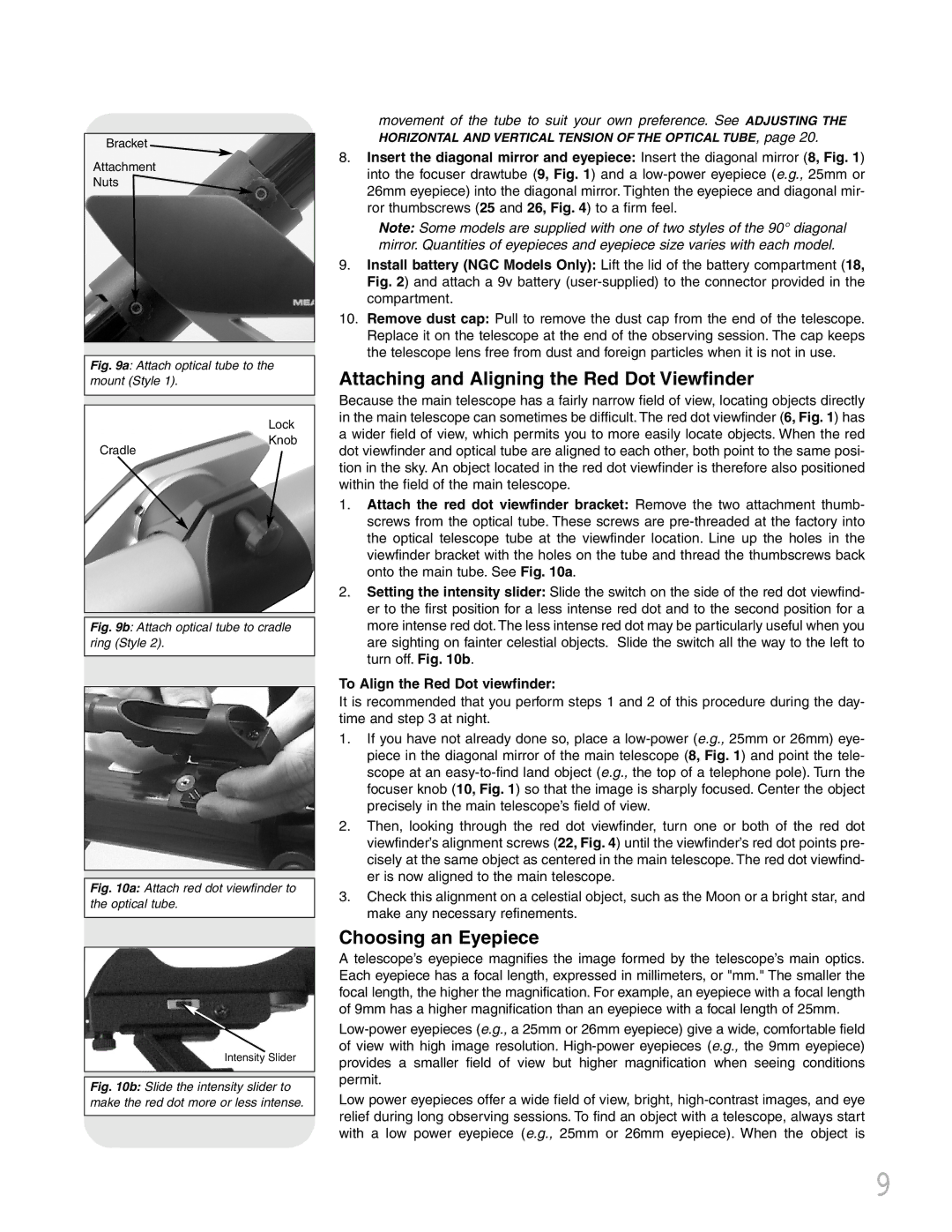
Bracket
Attachment
Nuts
Fig. 9a: Attach optical tube to the mount (Style 1).
Lock
Knob
Cradle
Fig. 9b: Attach optical tube to cradle ring (Style 2).
Fig. 10a: Attach red dot viewfinder to the optical tube.
Intensity Slider
Fig. 10b: Slide the intensity slider to make the red dot more or less intense.
movement of the tube to suit your own preference. See ADJUSTING THE HORIZONTAL AND VERTICAL TENSION OF THE OPTICAL TUBE, page 20.
8.Insert the diagonal mirror and eyepiece: Insert the diagonal mirror (8, Fig. 1) into the focuser drawtube (9, Fig. 1) and a
Note: Some models are supplied with one of two styles of the 90° diagonal mirror. Quantities of eyepieces and eyepiece size varies with each model.
9.Install battery (NGC Models Only): Lift the lid of the battery compartment (18, Fig. 2) and attach a 9v battery
10.Remove dust cap: Pull to remove the dust cap from the end of the telescope. Replace it on the telescope at the end of the observing session. The cap keeps the telescope lens free from dust and foreign particles when it is not in use.
Attaching and Aligning the Red Dot Viewfinder
Because the main telescope has a fairly narrow field of view, locating objects directly in the main telescope can sometimes be difficult. The red dot viewfinder (6, Fig. 1) has a wider field of view, which permits you to more easily locate objects. When the red dot viewfinder and optical tube are aligned to each other, both point to the same posi- tion in the sky. An object located in the red dot viewfinder is therefore also positioned within the field of the main telescope.
1.Attach the red dot viewfinder bracket: Remove the two attachment thumb- screws from the optical tube. These screws are
2.Setting the intensity slider: Slide the switch on the side of the red dot viewfind- er to the first position for a less intense red dot and to the second position for a more intense red dot. The less intense red dot may be particularly useful when you are sighting on fainter celestial objects. Slide the switch all the way to the left to turn off. Fig. 10b.
To Align the Red Dot viewfinder:
It is recommended that you perform steps 1 and 2 of this procedure during the day- time and step 3 at night.
1.If you have not already done so, place a
2.Then, looking through the red dot viewfinder, turn one or both of the red dot viewfinder’s alignment screws (22, Fig. 4) until the viewfinder’s red dot points pre- cisely at the same object as centered in the main telescope. The red dot viewfind- er is now aligned to the main telescope.
3.Check this alignment on a celestial object, such as the Moon or a bright star, and make any necessary refinements.
Choosing an Eyepiece
A telescope’s eyepiece magnifies the image formed by the telescope’s main optics. Each eyepiece has a focal length, expressed in millimeters, or "mm." The smaller the focal length, the higher the magnification. For example, an eyepiece with a focal length of 9mm has a higher magnification than an eyepiece with a focal length of 25mm.
Low power eyepieces offer a wide field of view, bright,
9
